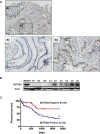Oncogenic roles of the SETDB2 histone methyltransferase in gastric cancer
- PMID: 27572307
- PMCID: PMC5341872
- DOI: 10.18632/oncotarget.11625
Oncogenic roles of the SETDB2 histone methyltransferase in gastric cancer
Abstract
SETDB2 is a histone H3 lysine 9 (H3K9) tri-methyltransferase that is involved in transcriptional gene silencing. Since it is still unknown whether SETDB2 is linked to carcinogenesis, we studied alterations and functions of SETDB2 in human gastric cancers (GCs). SETDB2 protein was highly expressed in 30 of 72 (41.7%) primary GC tissues compared with their normal counterparts by immunohistochemistry. SETDB2 overexpression was significantly associated with the late stage of GCs (P<0.05) and poor prognosis of GC patients (P<0.05). The GC cell lines with SETDB2 knockdown and overexpression significantly decreased and increased cell proliferation, migration and invasion, respectively (P<0.05). Knockdown of SETDB2 in MKN74 and MKN45 cells reduced global H3K9 tri-methylation (me3) levels. Microarray analysis indicated that expression of WWOX and CADM1, tumor suppressor genes, was significantly enhanced in MKN74 cells after SETDB2 knockdown. Chromatin immunoprecipitation assays showed that the H3K9me3 levels at the promoter regions of these two genes corresponded to the SETDB2 expression levels in GC cells. Moreover, ectopic SETDB2 protein was recruited to their promoter regions. Our data suggest that SETDB2 is associated with transcriptional repression of WWOX and CADM1, and hence overexpression of SETDB2 may contribute to GC progression.
Keywords: H3K9me3; SETDB2; gastric cancer; histone methyltransferase.
Conflict of interest statement
All authors declare that they have no conflict of interest to disclose.
Figures






Similar articles
-
Emerging roles of H3K9me3, SETDB1 and SETDB2 in therapy-induced cellular reprogramming.Clin Epigenetics. 2019 Mar 8;11(1):43. doi: 10.1186/s13148-019-0644-y. Clin Epigenetics. 2019. PMID: 30850015 Free PMC article. Review.
-
Reduced expression of SET7/9, a histone mono-methyltransferase, is associated with gastric cancer progression.Oncotarget. 2016 Jan 26;7(4):3966-83. doi: 10.18632/oncotarget.6681. Oncotarget. 2016. PMID: 26701885 Free PMC article.
-
Depletion of G9a gene induces cell apoptosis in human gastric carcinoma.Oncol Rep. 2016 May;35(5):3041-9. doi: 10.3892/or.2016.4692. Epub 2016 Mar 17. Oncol Rep. 2016. PMID: 27081761
-
Histone lysine methyltransferase SETDB2 suppresses NRF2 to restrict tumor progression and modulates chemotherapy sensitivity in lung adenocarcinoma.Cancer Med. 2023 Mar;12(6):7258-7272. doi: 10.1002/cam4.5451. Epub 2022 Dec 12. Cancer Med. 2023. PMID: 36504353 Free PMC article.
-
Aberrant histone methylation and the effect of Suv39H1 siRNA on gastric carcinoma.Oncol Rep. 2014 Jun;31(6):2593-600. doi: 10.3892/or.2014.3135. Epub 2014 Apr 14. Oncol Rep. 2014. PMID: 24737085
Cited by
-
The Emerging Roles of Heterochromatin in Cell Migration.Front Cell Dev Biol. 2020 May 27;8:394. doi: 10.3389/fcell.2020.00394. eCollection 2020. Front Cell Dev Biol. 2020. PMID: 32528959 Free PMC article. Review.
-
SETDB2 interacts with BUBR1 to induce accurate chromosome segregation independently of its histone methyltransferase activity.FEBS Open Bio. 2024 Mar;14(3):444-454. doi: 10.1002/2211-5463.13761. Epub 2024 Jan 9. FEBS Open Bio. 2024. PMID: 38151757 Free PMC article.
-
Emerging roles of H3K9me3, SETDB1 and SETDB2 in therapy-induced cellular reprogramming.Clin Epigenetics. 2019 Mar 8;11(1):43. doi: 10.1186/s13148-019-0644-y. Clin Epigenetics. 2019. PMID: 30850015 Free PMC article. Review.
-
DNA Methylation Readers and Cancer: Mechanistic and Therapeutic Applications.Front Oncol. 2019 Jun 11;9:489. doi: 10.3389/fonc.2019.00489. eCollection 2019. Front Oncol. 2019. PMID: 31245293 Free PMC article. Review.
-
Oncogenic Roles Of A Histone Methyltransferase SETDB2 In AML1-ETO Positive AML.Cancer Manag Res. 2020 Feb 4;12:783-792. doi: 10.2147/CMAR.S227036. eCollection 2020. Cancer Manag Res. 2020. PMID: 32099474 Free PMC article.
References
-
- Ferlay J, Soerjomataram I, Dikshit R, Eser S, Mathers C, Rebelo M, Parkin DM, Forman D, Bray F. Cancer incidence and mortality worldwide: sources, methods and major patterns in GLOBOCAN 2012. Int J Cancer. 2015;136:E359–386. - PubMed
-
- Yuasa Y. Control of gut differentiation and intestinal-type gastric carcinogenesis. Nat Rev Cancer. 2003;3:592–600. Review. - PubMed
-
- Wanajo A, Sasaki A, Nagasaki H, Shimada S, Otsubo T, Owaki S, Shimizu Y, Eishi Y, Kojima K, Nakajima Y, Kawano T, Yuasa Y, Akiyama Y. Methylation of the calcium channel-related gene, CACNA2D3, is frequent and a poor prognostic factor in gastric cancer. Gastroenterology. 2008;35:580–590. - PubMed
-
- Albert M, Helin K. Histone methyltransferases in cancer. Semin Cell Dev Biol. 2010;21:209–220. - PubMed
-
- Rodriguez-Paredes M, Martinez de Paz A, Simó-Riudalbas L, Sayols S, Moutinho C, Moran S, Villanueva A, Vázquez-Cedeira M, Lazo PA, Carneiro F, Moura CS, Vieira J, Teixeira MR, et al. Gene amplification of the histone methyltransferase SETDB1 contributes to human lung tumorigenesis. Oncogene. 2014;33:2807–2813. - PMC - PubMed
MeSH terms
Substances
LinkOut - more resources
Full Text Sources
Other Literature Sources
Medical
Research Materials
Miscellaneous

